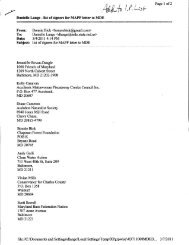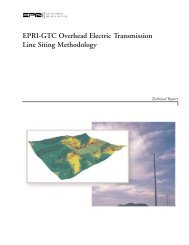Mid-Atlantic Power Pathway Chalk Point Substation to Indian River ...
Mid-Atlantic Power Pathway Chalk Point Substation to Indian River ...
Mid-Atlantic Power Pathway Chalk Point Substation to Indian River ...
You also want an ePaper? Increase the reach of your titles
YUMPU automatically turns print PDFs into web optimized ePapers that Google loves.
<strong>Mid</strong>-<strong>Atlantic</strong> <strong>Power</strong> <strong>Pathway</strong> Environmental Review Document<br />
<strong>Chalk</strong> <strong>Point</strong> <strong>Substation</strong> <strong>to</strong> <strong>Indian</strong> <strong>River</strong> <strong>Substation</strong> Volume II – Environmental Analysis of<br />
April 13, 2011 <strong>Chalk</strong> <strong>Point</strong> <strong>Substation</strong> <strong>to</strong> MD/DE State Line<br />
1.1.1.3 Geologic Hazards<br />
Geologic hazards in the region crossed by the Project are minor and include areas of low <strong>to</strong> moderate<br />
seismic activity and low incidence of landslides. Karst terrain and areas with the potential for ground<br />
failure due <strong>to</strong> subsidence, slumping, and landslides are not common in the Project area. Volcanism is not<br />
relevant <strong>to</strong> the region surrounding the Project and is not evaluated here (National Atlas 2009).<br />
1.1.1.3.1 Seismicity and Faults<br />
Seismicity refers <strong>to</strong> the geographic and his<strong>to</strong>rical distribution of earthquakes. Faults are fractures in rock<br />
that provide evidence of past geologic movement. Earthquakes are caused by stress building up along a<br />
fault until a critical limit is reached and the stress is released through sudden movement along the fault,<br />
causing energy <strong>to</strong> radiate from the fault in traveling ground waves. Hazards associated with seismicity<br />
and faulting include ground shaking, surface rupture of faults, and offset along normal, reverse, or strikeslip<br />
faults. Faulting can be hazardous <strong>to</strong> linear, rigid structures such as bridges and pipelines, since the<br />
ground could move in differing distances or directions at the fault.<br />
Seismic activity can be described in terms of magnitude and intensity, where magnitude characterizes the<br />
<strong>to</strong>tal energy released, and intensity describes impacts on a site-specific basis. The magnitude of a seismic<br />
event is most commonly measured by the Richter Magnitude Scale, where the magnitude of the event is<br />
expressed in whole numbers and decimals. The scale runs from a 1.0 <strong>to</strong> 8.0+, with 5.0 being considered a<br />
moderate event; 6.0 a strong event; 7.0 a major earthquake; and a devastating earthquake exceeding 8.0.<br />
Events with a magnitude less than 3.5 are generally considered imperceptible <strong>to</strong> most persons and in most<br />
situations.<br />
Earthquakes do occur in Maryland; however, the seismic risk is considered low. The epicenter of 61<br />
earthquakes has been documented in Maryland from 1756 through 2003. All of these were low intensity,<br />
low magnitude earthquakes; the maximum magnitude was 3.7 on the Richter Magnitude Scale and most<br />
were less than 3.0. The most recent was a magnitude 3.6 on July 16, 2010 centered approximately 54<br />
miles north-northwest of the Project area near Rockville, Maryland. Additional earthquakes originating<br />
in neighboring states can also occasionally be felt in Maryland.<br />
In general, Maryland is part of a seismically quiet zone (MGS 2007c). Seismic risk maps by the USGS<br />
and the MGS indicated low seismic risk (MGS 2007c; Peterson et. al., 2008; USGS 2007). The MGS<br />
map characterizes “all but the northeastern corner of the state as a ‘region of negligible seismicity with<br />
very low probability of collapse of the structure.’” Similarly, the entire Project area is located in an area<br />
classified by the Uniform Building Code as Seismic Zone 1 where earthquake activity is considered <strong>to</strong> be<br />
minor (U.S. Army Corp of Engineers [USACE] 1995).<br />
Based on the linear distance from active fault zones and the overall geologic setting of the Project area in<br />
Maryland, the geologic hazard associated with seismicity and faulting is not considered <strong>to</strong> be a significant<br />
risk.<br />
1.1.1.3.2 Soil Liquefaction<br />
Soil liquefaction is a condition that occurs when loose, cohesionless, saturated soil (usually well-sorted<br />
sand) is subjected <strong>to</strong> vibration or shock waves. During liquefaction, pore water inhibits grain-<strong>to</strong>-grain<br />
contact, and the strength of the soil is greatly reduced such that the soil may act like a viscous liquid with<br />
the ability <strong>to</strong> move and flow. Soil liquefaction can lead <strong>to</strong> landslides and earthflows, movement or failure<br />
of foundations and footings, and mobility of buried objects.<br />
1-8




